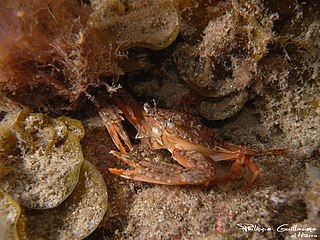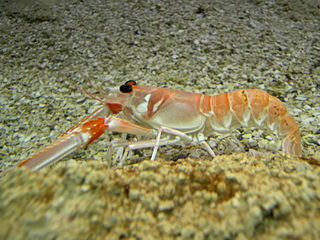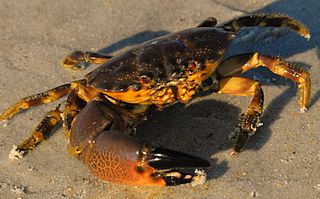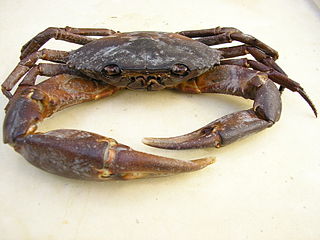
Portunus is a genus of crabs which includes several important species for fisheries, such as the blue swimming crab and the Gazami crab. Other species, such as the three-spotted crab are caught as bycatch.

Mary Jane Rathbun was an American zoologist who specialized in crustaceans. She worked at the Smithsonian Institution from 1884 until her death. She described more than a thousand new species and subspecies and many higher taxa.

Chionoecetes is a genus of crabs that live in the northern Pacific and Atlantic Oceans.

Xanthidae is a family of crabs known as gorilla crabs, mud crabs, pebble crabs or rubble crabs. Xanthid crabs are often brightly coloured and are highly poisonous, containing toxins which are not destroyed by cooking and for which no antidote is known. The toxins are similar to the tetrodotoxin and saxitoxin produced by puffer fish, and may be produced by bacteria in the genus Vibrio living in symbiosis with the crabs, mostly V. alginolyticus and V. parahaemolyticus.

Nephrops is a genus of lobsters comprising a single extant species, Nephrops norvegicus, and several fossil species. It was erected by William Elford Leach in 1814, to accommodate N. norvegicus alone, which had previously been placed in genera such as Cancer, Astacus or Homarus. Nephrops means "kidney eye" and refers to the shape of the animal's compound eye.

Pinnotheres is a genus of crabs, including the pea crab. Many species formerly in Pinnotheres have been placed in new genera, such as Zaops ostreus, the oyster crab and Nepinnotheres novaezelandiae, the New Zealand pea crab. The species currently recognised in the genus Pinnotheres are:

Mark C. "Marty" Rathbun is a former senior executive of the Church of Scientology who last held the post of Inspector General of the Religious Technology Center (RTC), the organization that is responsible for the protection and enforcement of all Dianetics and Scientology copyrights and trademarks.

Majidae is a family of crabs, comprising around 200 marine species inside 52 genera, with a carapace that is longer than it is broad, and which forms a point at the front. The legs can be very long in some species, leading to the name "spider crab". The exoskeleton is covered with bristles to which the crab attaches algae and other items to act as camouflage.

The bushveld elephant shrew or bushveld sengi is a species of elephant shrew in the family Macroscelididae. It is found in Angola, Botswana, Namibia, and South Africa. Its natural habitats are subtropical or tropical dry shrubland and hot deserts.

The grey-faced sengi is a species of elephant shrew that is endemic to the Udzungwa Mountains of south-central Tanzania. The discovery of the species was announced in January 2008; only 15 species of elephant shrew were known until then, and the last discovery was made more than 120 years ago. As the name implies, the species is characterised by a distinctive grey face and a black rump, as well as being larger than the other species of elephant shrews.

Menippe is a genus of true crabs. One of the best known species is the Florida stone crab. Most of the species of this genus are found in the Atlantic Ocean.

Dakoticancroidea is a superfamily of fossil crabs divided into the following two families:

Pugettia is a genus of kelp crabs in the family Epialtidae. It comprises the following species:

Linuparus, the spear lobsters, is a genus of medium-sized to large spiny lobsters in the family Palinuridae. It contains four extant species found at depths of 30–500 m (100–1,640 ft) in the Indo-Pacific, and 32 fossil species, ranging from the Early Cretaceous to the Oligocene. L. trigonus is the only extant species also known from the fossil record.

The Panopeidae are a family containing 26 genera of morphologically similar crabs, often known as "mud crabs". Their centers of diversity are the Atlantic Ocean and eastern Pacific Ocean.

Eurytium tristani is a species of crab in the family Panopeidae.

Hoploparia is a genus of fossil lobster belonging to the family Nephropidae. The type species of this genus is Hoploparia longimana.
Randallia is a genus of true crabs in the family Leucosiidae. There are about 17 described species in Randallia.

Leptuca is a genus of fiddler crabs belonging to the family Ocypodidae.


















